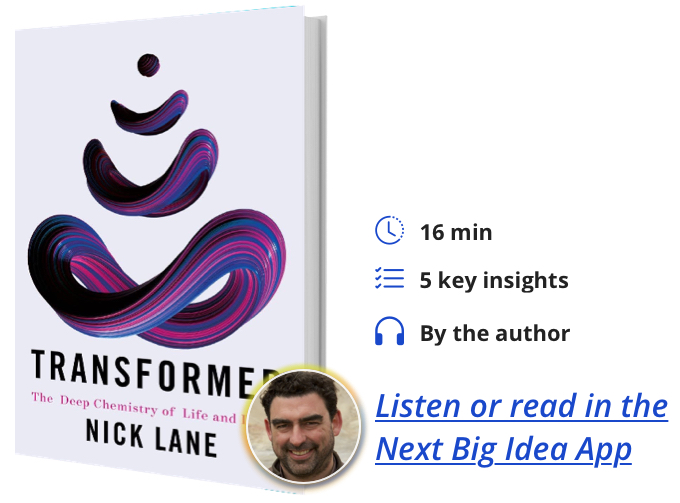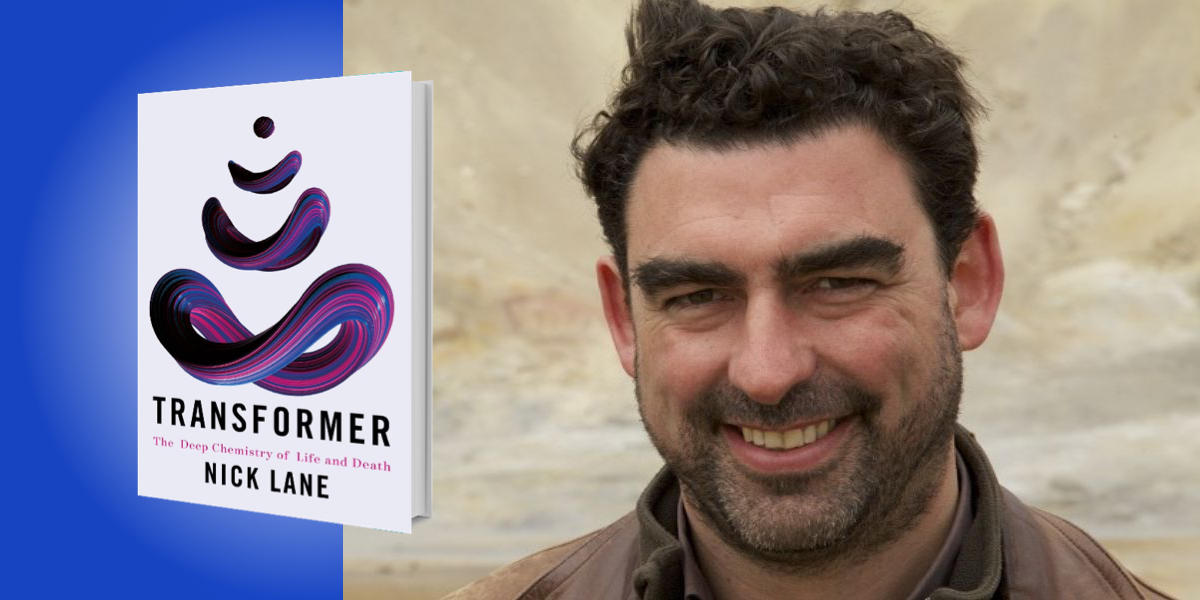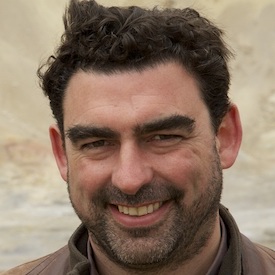Nick Lane is a professor of evolutionary biochemistry at University College London. He has won several awards for his science writing.
Below, Nick shares 5 key insights from his new book, Transformer: The Deep Chemistry of Life and Death. Listen to the audio version—read by Nick himself—in the Next Big Idea App.

1. In the beginning was the Krebs cycle.
At the heart of life is an amazing, conflicted merry-go-round of reactions called the Krebs cycle. This might seem like stuffy textbook biochemistry from decades ago, but it holds the secret to what brings a planet to life and our own lives to an end.
Most of us know the Krebs cycle as a cycle of biochemical reactions linked to energy generation in cells. In short, when we burn fuels like glucose in cell respiration, we first break them down into simpler molecules composed of carbon, hydrogen, and oxygen. These are the intermediates that make up the Krebs cycle. Then we strip out the carbon as CO2, and we burn the hydrogen in oxygen. The energy released is used to power an electrical charge on the membranes deep within our cells. This charge is as intense as a bolt of lightning—if you shrink yourself down to the size of a molecule, you’d feel an electrical charge of 30 million volts per meter!
The cycle of reactions that strips out CO2 and hydrogen from food to generate energy can operate in reverse in some of the most ancient bacteria. They use energy to turn gases from the environment—carbon dioxide and hydrogen—into the key building blocks of life, right at the heart of metabolism. Life makes everything else it needs from these molecules—amino acids to make proteins, lipids for membranes, and nucleotides for the informational molecules DNA and RNA.
What’s new is that the reactions that make up the Krebs cycle and onwards can occur spontaneously. The Krebs cycle is the engine of life, turning gases into living things. Genes emerged from this metabolic whirl. But now we’re faced with a strange situation: the Krebs cycle simultaneously creates and destroys, giving it a yin and yang that (I argue) still dictates how our genes work, including our risk of diseases.
2. Metabolism gives meaning to genetic information.
The three most important things about life are genetic information, energy flow, and metabolism. We tend to think that information is paramount—that genes determine everything else. But that view generates a serious paradox at the origin of life. Where does all this information come from? In fact, genes, energy, and metabolism have peculiarities that hint as to how they began. They suggest that energy flow and metabolism arose before genetic information—and still shape the action of genes.
“We tend to think that information is paramount—that genes determine everything else. But that view generates a serious paradox at the origin of life.”
The first peculiarity is that energy flow in biology is driven by electrical charges across the membrane that separates the inside of the cell from the outside world. Now we know that some geological environments, such as hydrothermal vents, have a similar microscopic topology in which electrical charges cross inorganic barriers surrounding cell-like pores. But what could such electrical charges do in an inorganic world? The answer is that electrical charges can drive the reaction between two stable, unreactive gases—carbon dioxide and hydrogen—to form Krebs cycle intermediates and all the rest of metabolism.
This is the second peculiarity: Life starts from hydrogen and CO2, and all metabolism follows spontaneously, right up to making the nucleotide building blocks of RNA and DNA. It doesn’t depend on genetic information but on thermodynamics. Metabolism is as spontaneous as water flowing downhill. It just happens. There’s no need for genes to direct it.
The third peculiarity is the genetic code itself. There are clues that hint at direct interactions between the letters in DNA and the amino acids of proteins. This means the code is not random. A random piece of RNA will template a small protein, giving it a sequence that is specified by those non-random interactions. If that speeds up metabolism—the Krebs cycle for example—then the random sequence will be selected. And that means there’s no problem with the origin of information in biology.
3. The first animals evolved through a high-wire metabolic balancing act.
Life started out using the Krebs cycle to convert gases into living cells—the engine of biosynthesis. But modern animals use it for biosynthesis and to generate energy. They can’t spin the cycle in both directions at the same time, so how did they manage?
The Krebs cycle is more of a roundabout than a complete cycle. The traffic flow of metabolism has to be controlled to do particular jobs. The single-celled organisms that came before animals could mostly do one thing at a time, so they needed to adjust their traffic flow. But animals have multiple tissues and can balance traffic flow through the Krebs cycle in one tissue differently than in another tissue. It’s a kind of symbiosis between mutually dependent tissues.
“The first animals arose in a desperate period of the Earth’s history, back when even the equator froze over at sea level, and oxygen levels in the ocean ‘see-sawed’ from high to low.”
The first animals arose in a desperate period of the Earth’s history, back when even the equator froze over at sea level, and oxygen levels in the ocean ‘see-sawed’ from high to low. The early animals that made it through those turbulent times were small worms that were good at burrowing through toxic muds with tenuous oxygen supplies. They had to deal with high concentrations of CO2 and the sewer gas hydrogen sulfide, clearing out their system quickly. That put a premium on the symbiosis between tissues.
One of the most famous periods in the history of life was the Cambrian explosion, when the earliest recognizable animals burst into the fossil record. There were other animals that came before them, the Ediacaran fauna, which mostly disappeared without a trace. They had simple morphology and lacked tissues, explaining their vulnerability to changing oxygen levels. They asphyxiated before the Cambrian explosion. When oxygen levels finally rose, our ancestors became turbocharged.
4. Metabolism is what being alive is—and explains why we age and die.
We are so aware of the vast amounts of information stored in our genes, that we sometimes overlook the obvious. There’s no difference in the information content between a living organism and one that died a moment ago. What stopped was metabolism.
Metabolism is the sum total of reactions occurring in an organism at any one moment. Metabolism keeps us alive—it is what being alive is. In one of our own cells, there are more than a billion metabolic reactions every second. That’s about a hundred billion trillion reactions in the last second, or a billion times the number of stars in the known universe. These reactions don’t all work properly, and damage inevitably accumulates.
As we age, our respiration slowly begins to run down, and that affects the way that the Krebs cycle spins. Instead of burning hydrogen stripped out from the Krebs cycle, or using intermediates to build the molecules of life, the cycle slows down or goes into reverse. Our cells start to behave like those ancient bacteria, fixing CO2, to make more of me. I slow down and put on weight. But the worst offenders are cancer cells, which switch Krebs cycle to a setting that maximizes growth.
“If we want to fight cancer, we need to oppose this epigenetic shift.”
We often think of cancer as a disease of the genome, an accumulation of mutations that turn our cells to the dark side. But the biggest risk factor for cancer is older age, and that has little to do with the accumulation of mutations. Instead, the slowing down of metabolism switches thousands of genes on or off, shifting our cells to a senescent epigenetic state that favors growth and mutations. If we want to fight cancer, we need to oppose this epigenetic shift.
5. Consciousness is real-time integrated feedback on our metabolic state.
What is a feeling—love or hunger or pain—in physical terms? There is no obvious reason why the release of neurotransmitters or the depolarization of neurons should feel like anything at all.
Let me cut to the quick. The inert gas xenon acts as an anesthetic and can facilitate the transfer of electrons to oxygen in cell respiration, but to our knowledge little else. That would play with the electrical charges on the membranes deep inside cells, and feedback on all aspects of metabolism through the Krebs cycle. It would connect the billions of reactions per second going on within our cells with a single integrated feedback: the electrical charge on membranes.
Moving electrical charges generate an electromagnetic field, and it may be that the fluctuating electrical patterns of the EEG, or electroencephalogram, reflect the activity of the membranes involved in respiration. An electromagnetic field can entrain water, and all the molecules within a cell, into a state of sympathetic oscillations. Might that resonance state feel like something?
Cell respiration takes place in mitochondria, the powerhouses of the cell, which were free-living bacteria once. The cell membrane of a bacterium separates and links it with the outside world. It transmutes everything important for a cell about that outside world into the language of metabolism, and encapsulates it as an electrical potential on the membrane.
A feeling is an electromagnetic field that captures, for each fleeting moment, how well a cell is doing, metabolically, in relation to the world, giving real-time integrated information on what to do next. Get it wrong—infected by a virus for example—and the bacterium will quickly pull the plug, collapsing the humming electrical potential on the membrane, and bringing its life to an end. Does that feel like something? How could it not? A feeling is intimately connected to the process of living. Emotions are what make us human, and it’s a beautiful thought that they also connect us through emotional vibrations to all the rest of life.
To listen to the audio version read by author Nick Lane, download the Next Big Idea App today:






























